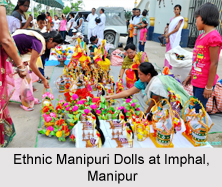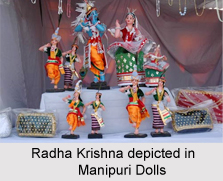 The very concept of doll making took birth in India for different reasons just like in any other country, the principal one being the religious angle, wherever there is image worship. It started with the making of images of deities by artisans who made them with devotion. The tradition continues today as many artisans earn their brand for entire year during festive occasions. Another impetus behind doll craft is credited to rich people or rulers who get their own replicas made, expecting others to worship, which is again a semi-religious and semi-social factor in a feudal society. The third reason is of course the dolls being made as toys for children to play with, of various designs and colour that attract them. Often certain dolls are made and used as part of educational programmes. Finally, dolls are crafted as simple home décor items for the modern day drawing room, dining room and even bed room. Dolls are crafted in different ways using various raw materials, like cloths or fabrics with or without stuffing and then decorated suitably. Clay is also used for dolls, which after moulding is painted and adorned with cloths. There are also clay images without cloths. There are dolls made from pulp, grasses and reeds, wood, stone and so on, with or without clothing. All these multifarious dolls are made according to the materials available around. Dolls today are also moulded out of plastic, often manufactured and marketed by the organised sector.
The very concept of doll making took birth in India for different reasons just like in any other country, the principal one being the religious angle, wherever there is image worship. It started with the making of images of deities by artisans who made them with devotion. The tradition continues today as many artisans earn their brand for entire year during festive occasions. Another impetus behind doll craft is credited to rich people or rulers who get their own replicas made, expecting others to worship, which is again a semi-religious and semi-social factor in a feudal society. The third reason is of course the dolls being made as toys for children to play with, of various designs and colour that attract them. Often certain dolls are made and used as part of educational programmes. Finally, dolls are crafted as simple home décor items for the modern day drawing room, dining room and even bed room. Dolls are crafted in different ways using various raw materials, like cloths or fabrics with or without stuffing and then decorated suitably. Clay is also used for dolls, which after moulding is painted and adorned with cloths. There are also clay images without cloths. There are dolls made from pulp, grasses and reeds, wood, stone and so on, with or without clothing. All these multifarious dolls are made according to the materials available around. Dolls today are also moulded out of plastic, often manufactured and marketed by the organised sector.
In the northeast Indian state of Manipur, doll making has been an ancient craft particularly in the valley. It grew with time and evolved with social changes and demand. The dolls were made on both religious and social bases, and as toys but imaginations changed with time just as materials did but in any case, the Manipuri impression and flavour remains intact till date.
Cloth Dolls of Manipur
In Manipur, dolls made by stitching and stuffing small pieces of cloths are crafted mostly as toys. Children, mostly girls, play with them and they are popular being unbreakable and not causing injury. They are made by artisans and mostly sold in "melas" (fairs) and occasionally in shops. But, cloth dolls of the state are facing tough competition from the imported dolls that are made using machines by the organised sector, partly procured from Far East through Myanmar and partly from the rest of India. The craft has thus languished with the passage of time and needs to be revived and sustained with appropriate inputs.
Clay Dolls of Manipur
Like any other place in India, clay models in Manipur started as part of image worship after the state was swept across by Hinduism. The images of deities like Krishna, Radha, Hanuman, Rama and even Gauranga Mahaprabhu were made of clay, moulded, painted and decorated with cloth or otherwise, and then worshipped during the festive occasions. Larger clay models are made on bamboo and straw frames, finished with paint and cloth. As the market demand triggered, dolls were made with the same material on the basis of social themes such as Manipuri dances, Khamba and Thoibi, Meithei marriages, Naga couples etc. These dolls were initially made for the people of Manipur who kept them in their homes as decoration pieces that also reflected their heritage. These dolls were also used as museum pieces or in exhibitions. Later, tourists who visited Manipur took these dolls as a symbol of remembrance and objects of decor. Subsequently, they were also exported. Also to make these dolls durable, Plaster of Paris was used instead of clay.
Wood Dolls of Manipur
Wooden toys were a traditional craft in Manipur since long, the state being blessed with all varieties of timber enough to produce any item out of wood. Besides wooden images produced both on the hills and in the valley, many carpenters produce toys of various kinds, ranging from railway engines, cars, buses, scooters to images of human figures, animals and birds. Those artisans having artistic imagination craft out goods which become decorative pieces. Wooden dolls of the state are still very popular in spite of the competition, and are sold freely in "melas", exhibitions and in shops. Many of them are exported as well.
Grass and Fibre Dolls of Manipur
Dolls made from grasses and natural fibres are typical of Manipur, attractive enough to be not only sold as toys but also as decorative pieces. The dolls are crafted from grass and natural fibre by twisting, knotting etc., and are dyed either before the process or after. Apart from toys and decorative items, such dolls are also being used as car dolls today.
Cane and Bamboo Dolls of Manipur
Cane and Bamboo are omnipresent in Manipur and cane and bamboo craft is most prominent and native to the state. A myriad range of items are made out of cane and bamboo in Manipur and while making these items, like furniture etc., small pieces of cane and bamboo are left over. But the crafty Meitheis, Lois, Kukis and Nagas of the state do not let these leftover pieces go waste, by making dolls, toys and decorative items using them, thereby also ensuring additional earnings. The range of products though, however numerous, cannot be uniform and well-categorised since the end product depends on artisans" imagination along with the type and size of the pieces.
Therefore, Manipur is a land of toys and dolls, which are as elegant and attractive as the girls and women of the state. The dolls represent so much of a real look that one may imagine dwarf Khamba and Thoibi standing before them in their dancing attire.
Related Articles:
Manipur
Nagas
Kukis
Cane and Bamboo Crafts of Manipur
Crafts of Manipur
Manipuri Dance
Clay Crafts of India
Wood Craft
Stone Art, India
Khamba and Thoibi



















